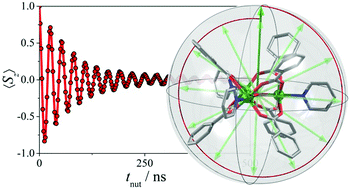Relevance of Dzyaloshinskii–Moriya spectral broadenings in promoting spin decoherence: a comparative pulsed-EPR study of two structurally related iron(iii) and chromium(iii) spin-triangle molecular qubits†
Abstract
Spectral broadenings due to Dzyaloshinskii–Moriya interactions (DMI) were assessed with respect to the decoherence they induce through increased spin–spin interactions, as the role of DMI in developing magnetoelectric spin-chirality qubits is gaining recognition. The structurally related spin triangles [Fe3O(PhCOO)6(py)3]ClO4·py (Fe3) and [Cr3O(PhCOO)6(py)3]ClO4·0.5py (Cr3) were studied as frozen py-d5 solutions with various pulsed Electron Paramagnetic Resonance (EPR) spectroscopy experiments, and under identical experimental conditions. Field-swept Hahn echo experiments revealed a match with continuous-wave (CW) spectra, while variable-temperature saturation/inversion recovery and Hahn echo decay experiments were used to extract the thermal evolutions of the spin–lattice relaxation and phase-memory times (T1 and Tm, respectively). Nutation experiments revealed Rabi oscillations demonstrating that the spins of the complexes could be coherently manipulated. Careful comparisons of Tm times confirmed hyperfine interactions with the magnetic nuclei of the metal ions as an intrinsic source of decoherence. Comparisons of Rabi damping times revealed that DMI-induced spectral broadenings play a discernible but moderate role as an extrinsic source of decoherence for the nutation experiments and that they are not particularly detrimental to spin manipulations.



 Please wait while we load your content...
Please wait while we load your content...